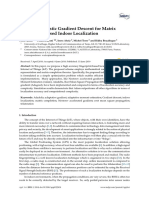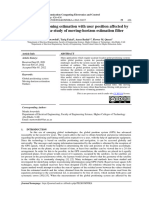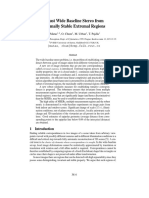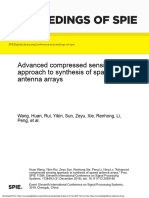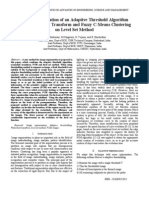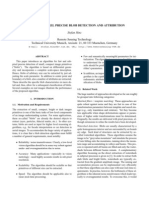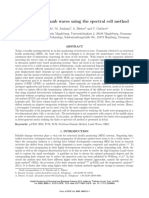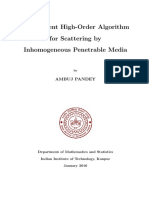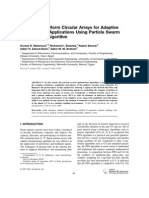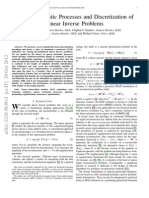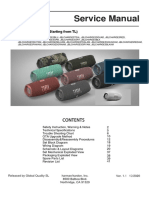Integrated Denoising and Unwrapping of Insar Phase Based On Markov Random Fields
Integrated Denoising and Unwrapping of Insar Phase Based On Markov Random Fields
Uploaded by
Sakthidasan SankaranCopyright:
Available Formats
Integrated Denoising and Unwrapping of Insar Phase Based On Markov Random Fields
Integrated Denoising and Unwrapping of Insar Phase Based On Markov Random Fields
Uploaded by
Sakthidasan SankaranOriginal Title
Copyright
Available Formats
Share this document
Did you find this document useful?
Is this content inappropriate?
Copyright:
Available Formats
Integrated Denoising and Unwrapping of Insar Phase Based On Markov Random Fields
Integrated Denoising and Unwrapping of Insar Phase Based On Markov Random Fields
Uploaded by
Sakthidasan SankaranCopyright:
Available Formats
This article has been accepted for inclusion in a future issue of this journal.
Content is final as presented, with the exception of pagination.
IEEE TRANSACTIONS ON GEOSCIENCE AND REMOTE SENSING 1
Integrated Denoising and Unwrapping of InSAR
Phase Based on Markov Random Fields
Runpu Chen, Weidong Yu, Member, IEEE, Robert Wang, Senior Member, IEEE, Gang Liu, and Yunfeng Shao
AbstractIn the traditional processing ow of interferometric
synthetic aperture radar (SAR) technique, the processing of phase
is conducted via two separated and successive steps, i.e., phase
denoising and phase unwrapping. That is to say, rst, wrapped
phases without noise are generated, and then, the true phases with-
out 2-ambiguities are reconstructed (here and in the rest of this
paper, true phase refers to the information-induced unwrapped
phase without noise). Such separated steps will inevitably bring in
extra estimation error because each step has necessary approxima-
tions and presumptions which do not always hold. On the contrary,
in this paper, we treat phase denoising and unwrapping as a single
problem of true phase recovery from observed ones. Following
this methodology, an integrated phase denoising and unwrapping
algorithm based upon Markov random elds (MRFs) is proposed.
Taking a priori knowledge of interferometric phases into account,
MRF is used to model the relationship between the elements in
the random variable set including both true phases and their
observations. After the model is built up, the energy function of
this MRF is dened according to the local-independence property
inferred from the MRF structure and then minimized to obtain
the estimate of the true phase value. In the end of this paper,
experiments on simulated and true phase data are conducted, and
the comparison with several commonly used unwrapping methods
is proposed to verify the efciency of the proposed MRF algorithm.
Index TermsImage restoration, interferometric synthetic
aperture radar (SAR) (InSAR), Markov random elds (MRFs),
phase denoising, phase recovery, unwrapping.
I. INTRODUCTION
T
HE interferometric synthetic aperture radar (SAR)
(InSAR) technique is a tool for measuring the elevation
or deformation of the Earths surface. InSAR-related technique
is a big family, including InSAR, differential SAR interfer-
ometry (DInSAR) [1], permanent scatterer SAR interferometry
(PSInSAR) [2], small baseline subset (SBAS) [3], etc. Because
of the fast development of processing algorithms and applica-
tions, InSAR has been proven as an effective tool in the elds
of geosciences, mapping, and meteorology.
All InSAR-related techniques have a similar principle to
infer the useful information from interferometric phases. There-
fore, the processing of phase images is with big signicance
in their implementation. In the conventional InSAR owchart,
Manuscript received June 30, 2012; revised May 8, 2013 and June 4, 2013;
accepted June 4, 2013.
The authors are with the Department of Space Microwave Remote Sens-
ing System, Institute of Electronics, Chinese Academy of Sciences, Beijing,
China (e-mail: ywd@mail.ie.ac.cn; yuwang@mail.ie.ac.cn; liugangiecas@
gmail.com; shao-yun-feng@163.com).
Color versions of one or more of the gures in this paper are available online
at http://ieeexplore.ieee.org.
Digital Object Identier 10.1109/TGRS.2013.2268969
the processing of phase is carried out via two separated and
successive steps, i.e., phase denoising and unwrapping. A brief
description of these two steps is provided in the following.
InSAR makes use of two or more SAR images covering a
same scene to generate interferograms. Limited by SAR system
property and imaging geometry, the acquired interferometric
phases contain not only the information-induced terms but also
noise terms, including system thermal noise and corregistration
error. Therefore, before further processes, phase denoising is
the rst step to eliminate phase noise while preserving infor-
mation.Taking the characteristics of the interferometric phase
into consideration, there are several phase denoising approaches
[4][6] and their improvements [7][9]. The phase denoising al-
gorithms can be divided into two categories: image domain and
frequency domain algorithms. The rst category is carried out
in local windows in the image domain, and their improvements
often focus on the design of local windows, i.e., size, direction,
and the weight distribution inside the windows [7], [8]. The
second category is carried out in the frequency domain [6], and
their improvements are on the choice of parameter using some
kinds of quality maps, e.g., coherence coefcient maps [8].
Because of the periodic nature of phase, only the principal
values of phase, modulo 2, can be directly obtained from
interferograms. Therefore, the purpose of phase unwrapping
(PhU) is to recover the true phases from the directly observed
wrapped phases in the interval [, ). Since the mapping from
true phases to wrapped phases is multiple to single, no direct
analytical solution exists for its inversion, i.e., PhU problem.
Thus, only with the help of some a priori knowledge can
true phases be recovered. The PhU algorithms can be divided
into two categories: path-following and global optimization
approaches. The rst category of algorithms is based upon the
integration in the gradient eld along chosen paths [10]; hence,
they always generate 2-true estimation. The well-accepted
algorithms in this category include Goldsteins branch-cut al-
gorithm [11], quality map [12], minimum discontinuity [13],
etc. Goldsteins branch-cut algorithm [11] treats residues as the
source of error propagation. First, residues are detected and
connected with branch cuts to balance their charges. Then, the
gradient eld is integrated along the paths around the branch
cuts to keep away from residues. Following the similar method-
ology, the quality-map unwrapper [12] assumes that pixels with
high quality (e.g., interferometric coherence coefcient) are
with less probability to cause error propagation; therefore, it
uses the quality map as the indicator to track the integration
paths. Flynn developed a minimum discontinuity algorithm to
nd the solution that exactly minimizes the discontinuities in
the phase map [13]. This algorithm utilizes a tree-growing
0196-2892/$31.00 2013 IEEE
This article has been accepted for inclusion in a future issue of this journal. Content is final as presented, with the exception of pagination.
2 IEEE TRANSACTIONS ON GEOSCIENCE AND REMOTE SENSING
approach that traces paths of discontinuities in the phase, de-
tects loops, and adds multiples of 2 to the phase values en-
closed by the loops. The rst category of algorithms, although
2-true, are sensitive to the Itoh conditions which are often
violated in the 2-D case. The second category of algorithms
is based on global optimization, such as minimum Lp-norm
methods, including least square (LS) tting, minimum cost ow
(MCF) approach, etc. The LS-tting algorithm, the p = 2 case
of Lp-norm approaches, processes LS tting on the gradient
eld of absolute phase and wrapped phase [14], [15]. The
MCF algorithm, the p = 1 case of the Lp-norm method, was
proposed by Costantini [16]. In [16], the optimization problem
is solved by network programming. The MCF approach is
proved to be stable with respect to the propagation of PhU
errors from incoherent to coherent areas. What is more, al-
though the MCF algorithm needs to solve integer problems,
only when the number of pixels to be analyzed is extremely
high will the problem become intractable. In normal cases,
the computational burden is under control. However, Chen and
Zebker have proved that the p = 0 case is NP-hard; therefore,
only approximated L0 norm solutions can be achieved [17].
The second category of unwrappers usually suffers from high
computational burden, particularly when dealing with large-
scale interferograms. Moreover, the LS-tting algorithm gener-
ates errors smoothly distributed on the whole phase image while
the MCF approach, as a 2-true unwrapper, induces integer
times of 2 error on discrete points.
In recent years, as the multitemporal/multibaseline InSAR
attracted increasing interests, it is with signicance to unwrap
interferogram series to support these techniques [2], [3]. The
interferogram series unwrapping is meant to recover the un-
derlying information contained in the multitemporal/baseline
interferograms with or without the direct InSAR phase series
unwrapping. In 2004, the Least-squares AMBiguity Decorrela-
tion Adjustment (LAMDA) algorithm [18] was borrowed from
GPS technique to solve the phase ambiguity problem in PSIn-
SAR. This algorithm aims at nding the optimum estimation
under the integer constraint of phase ambiguity number. In
2011, Yu et al. developed a multibaseline PhU algorithm based
on cluster analysis [19]. This approach converts PhU into a
straight line clustering problem; hence, a fast CLUSTER analysis
(CA)-based method is applied for unwrapping interferogram
series. In 2011, the extended 3-D (2-D image plus 1-D time)
MCF algorithm was developed by Pepe et al. and applied in
SBAS technique [20]. The approach in [20] is based on the joint
analysis of the spatial and temporal relationships among a set
of interferograms in SBASs. This algorithm carries out rst the
MCF unwrapping in T B domain (the timebaseline domain)
and, then, in the image domain. Therefore, it is referred to as
a two-step (TS) algorithm. Based on the TS scheme, in 2011,
Fornaro et al. proposed a null-space approach [21] to unwrap
multitemporal InSAR stacks. Through the analysis on the null-
space matrix associated with the relationship between the phase
differences and the true phase value, the overdetermined linear
system is solved.
However, the separated two steps of denoising and unwrap-
ping will cause extra errors BECAUSE each step has inevitable
algorithm noise both in single-baseline and multibaseline
InSAR occasions. The acquisition of the interferometric phase
can be regarded as a single process of interferometric phase
observation. Therefore, separately improving the algorithms of
denoising and unwrapping will not achieve true phase recon-
struction radically because, even if the unwrapping algorithm
can generate the exact results, it cannot overcome the error
brought in by the denoising step and vice versa.
Because of the aforementioned reason, in this paper, we
treat interferometric phase denoising and unwrapping as an
integrated problem of true phase reconstruction from obser-
vation. Then, it is very similar to the restoration of image
or imagelike data for two reasons. First, the interferograms
can be considered as the observations of the noise-polluted
true phases, and this fact generates the similarity between the
principal values of true phases and their observations. Second,
the true phase is believed to be continuous in the image domain
because its components generated from different sources are all
continuous. These two presuppositions, referred to as closeness
and smoothness properties, perform as the a priori knowledge
in the true phase recovery problem, and they are very similar to
the well-accepted features of degenerated image restoration.
Based on this methodology, we utilize Markov random elds
(MRFs) as a tool to analyze the true phase reconstruction
problem. The major advantage of MRFs lies in their ability to
take contextual information into account [22]. MRFs were rst
introduced in image and imagelike data processing by Besag
in 1974 [23]. Since proposed, they have been widely used
for image segmentation, classication, and image restoration.
Compared to some commonly used algorithms, the proposed
MRF approach in this paper has four major advantages. First,
it integrates interferogram denoising and PhU into a single
process of true phase recovery from observation and therefore
prevents the error propagation from the former to the latter.
Second, neither the reconstruction of phase ambiguities nor the
integration in the gradient eld is needed in the PROPOSED
MRF algorithm; therefore, the problems of integer number
solving and path choosing are avoided. What is more, it does
not need the exact probability distribution function of the
observed phase and noise term; instead, it is only based on the
direct assumptions which usually hold for InSAR occasions.
Finally, making use of local properties of interferograms, i.e.,
coherence coefcient maps, this algorithm turns into a local-
adaptive process of interferograms, which can generate more
robust estimate of the true phase.
MRF has been used to solve the phase denoising or unwrap-
ping problems in several APPROACHES. In 2002, Suksmono and
Hirose proposed an MRF-based phase denoising approach [24].
This approach utilizes fth-order noncausal complex MRF to
model the local-stationary condition and estimate the complex
value on the residues. After the ltering step, Goldsteins
branch-cut unwrapper is applied to evaluate the performance
of the proposed algorithm. In 2007, Bioucas-Dias and Valadao
proposed a PhU algorithm based on graph cuts [25]. This
algorithm uses a new energy minimization function induced
from rst-order MRFs. The optimization objective is the phase
ambiguity number on each pixel, which is achieved through
a series of binary optimization. Therefore, the problem of
ambiguity number estimation is converted to the {0, 1}-cut
This article has been accepted for inclusion in a future issue of this journal. Content is final as presented, with the exception of pagination.
CHEN et al.: INTEGRATED DENOISING AND UNWRAPPING OF INSAR PHASE BASED ON MRFs 3
Fig. 1. Transformation relationship between true phase and observed phase.
of graphs, so the graph-cut approach is utilized. Using some
simulation experiments, the authors validated that this ap-
proach, referred to as Phase Unwrapping Max-ow/min-cut
(PUMA), provides good results. Following a similar way, in
2009, Ferraioli et al. developed a multichannel graph-cut un-
wrapping algorithm [26]. This algorithm is meant to directly
reconstruct target height h from the interferometric phase series
through a graph-cut approach similar to the previously men-
tioned algorithm. Our algorithm differs from these approaches
in two aspects: First, the proposed MRF algorithm is an inte-
grated phase denoising and unwrapping scheme, and second,
our algorithm is not 2-true; hence, no integer solving or
discrete label problem is included in the algorithm.
In this paper, the algorithm is developed mainly for the
situation of single-pass interferometry or short-period single-
baseline interferometry, where the topography of the Earths
surface can be thought as the unique source of true interfer-
ometric phases. However, it does not mean that this algorithm
cannot be applied when the displacement and atmosphere effect
exist. Since the algorithm is based on the local property anal-
ysis, it does not fail when the displacement and atmospheric
phases are locally continuous, which is usually THE true case.
On the other hand, the proposed MRF algorithm can be ex-
tended into the 3-D version to solve the multibaseline/temporal
InSAR PhU problem via a similar method as the existing
3-D PhU approaches. In the future, we will nd a proper way to
extend this algorithmfor the interferogramseries reconstruction
problem.
The rest of this paper is organized as follows: Section II
describes the model of the interferometric phase generation
process and its MRF representation. Section III introduces
the proposed MRF algorithm. Section IV gives the simulation
experiment and the comparison between the proposed MRF al-
gorithm and several competing algorithms. Section V is the real
data experiment in which some deeper analysis and comparison
is provided.
II. MODEL DESCRIPTION AND THE INTRODUCTION
OF MRF PRESENTATION
According to the mechanism of InSAR techniques, the trans-
formation relationship between observation and true phase val-
ues is shown in Fig. 1. The goal of true phase reconstruction is
achieved through an inverse solution of the observation process.
The inversion problem of observation can be depicted by a
Fig. 2. Graphical model representing phase data properties.
random variable generation process in which the true phases
and their observation are both regarded as random variables.
As a result, the solution of the inversion problem is achieved
through the maximum a posteriori (MAP) estimation of true
phases, given the observations and the known observation
model depicted in Fig. 1
= arg max
_
P(|
)
_
. (1)
In (1),
is the estimation of the true phase , and
is the
observation of , which is also known as the (wrapped and
noised) interferometric phase.
Based on the physical principle of the process, there exist two
kinds of relationships between these variables: The rst is the
relationship between adjacent locations (i.e., the relationship
between the true phase values on adjacent coordinates), and
the second is the stochastical dependence between the observed
phases and the true phase. As a result, our model is designed
to include two different structures respectively describing the
two kinds of relationships. Concretely, our model is visually
shown in Fig. 2 where the unlled nodes denote the true phase
variables, while the lled nodes mean their observation.
Now, we deeply analyze the rationality of the model in
Fig. 2. According to theory of the probabilistic graphical model
[27], the above structure implies two sources of conditional
independence. Here, we provide a brief denition of conditional
independence [28]. For variables a, b, and c, if the following is
true, a is conditionally independent with b given c:
p(a, b|c) = p(a|c)p(b|c). (2)
The notation in (2) denotes the conditional independent
property between a and b given c.
The rst kind of conditional independence is that the obser-
vation is independent given the corresponding true phase with
all the other true phases, which means that the true phases,
once observed, provide the full information needed to predict
their observation. The second kind of conditional independence
relies in that, given its observed rst adjacent location, one
true phase variable is conditionally independent with all others,
which is represented in the graphic model by that only the
rst adjacents are connected with each other. Here, we choose
this structure because not only is it general enough to capture
the salient feature in the problem [29] but it also greatly
reduces the computational complexity of reference and learn-
ing by facterizing the joint probability distribution function.
The facterization and solution process is provided in detail in
the next section.
This article has been accepted for inclusion in a future issue of this journal. Content is final as presented, with the exception of pagination.
4 IEEE TRANSACTIONS ON GEOSCIENCE AND REMOTE SENSING
Fig. 3. Cliques in the graph illustrated in Fig. 2.
The model described earlier is referred to as MRF, a widely
used model that originated from stochastic mechanics, and now
used for describing a lot of phenomena. An MRF is a stochastic
process whose global properties are controlled by means of
local conditional independent properties. Here, we denote the
set of sites (lattice) by S Z
v
and the set of states by (here,
= R). = (S) =
S
means the set of the applications
from S in , also known as the universe. An element of the
universe is called an event or a conguration and is denoted by
S
. What is more, the state of the site s is denoted by
s
, and
the probability is denoted by P.
A random eld (, P) is Markovian if and only if
s S,
P (
s
= |
t
, t S {s}) = P(
s
= |
t
, t N
s
) (3)
where N
s
is a nite subset of S {s} consisting of the neigh-
bors of s. If the Markovian property holds, the eld (, P) is
known as an MRF. An MRF is usually visually depicted using
an undirected graphical model as Fig. 2.
Being a well-developed model, MRF provides several tech-
niques to solve the MAP estimation problem as (1), e.g., loopy
belief propagation [30], graph cut [31], etc. Unfortunately, these
algorithms deal with the discrete situation, while in our prob-
lem, real variables needed to be solved. As a result, a modied
version of the energy minimization algorithm introduced in
[23] is used to solve the real variable application problem. The
thorough algorithm description is provided in the next section.
III. DESCRIPTION OF THE ALGORITHM
A. Parameterization
The parameterization of an MRF only concerns the condi-
tional independent property over the eld. The factorization
of an MRF involves expressing the joint probability distribu-
tion function as a product of functions dened over sets of
variables that are local to its corresponding undirected graph
[32]. According to the analysis in [32], the undirected graph is
segmented into cliques, i.e., fully connected subgraphs.
Based on Fig. 3, a joint probability distribution function of
all the nodes in the graph can be dened as follows:
p(X) =
1
Z
C
(X
C
). (4)
In (4), X denotes the vector of all the nodes in an MRF,
C denotes the set of all the cliques, and the quantity Z is a
normalization constant and is given by
Z =
C
(X
C
). (5)
To make sure that
C
(X
C
) has the positive value, it is
dened as exponentials; thus
C
(X
C
) = exp {E
C
(X
C
)} . (6)
In (6), E
C
is referred to as the energy function, and the expo-
nential representation is called the Boltzmann distribution [32].
The joint distribution is dened as the product of potentials;
hence, the total energy is obtained by adding the energies of
each of the maximal cliques. In true phase estimation, only the
total energy function of the eld is minimized.
In order to give an exact formulation of the energy function,
the features of observed and true phases are analyzed. First,
observed phases should be close to the principal values of the
true phase, i.e., closeness property. Second, the interferometric
phase is regarded to be locally continuous because of the local
continuity of the sources of phase components like topography,
atmosphere screen, orbital error, and surface displacement.
These two presuppositions perform as a priori knowledge in
the phase recovery problem and help to generate the exact
formulation of the energy function. The energy function on each
maximal clique is given in
E(
i,j
) =
N
i,j
_
w1
i,j
(
i,j
)
2
+ w2
i,j
|exp {j(
i,j
i,j
)} 1|
2
_
. (7)
In (7),
i,j
denotes the observed phases on coordinate (i, j),
i,j
means the true phase value on coordinate (i, j), and N
i,j
means the rst-order neighbors of coordinate (i, j) in the true
phase grid. The rst part of (7) is deduced from the smoothness
property of the true phase, while the second part is deduced
from the closeness property of the true and the observed phase.
The weights w1
i,j
and w2
i,j
help to reach a balance between
smoothing and unwrapping calculations.
Thus, the total energy function of the MRF is
E() =
i,j
_
_
N
i,j
w1
i,j
(
i,j
)
2
+
i,j
w2
i,j
|exp {j(
i,j
i,j
)} 1|
2
_
_
. (8)
For the purpose to get the estimate
, the total energy
function E() in (8) is minimized
= arg
min E(). (9)
The minimization of (8) can achieve the goal of denoising
and unwrapping because it takes both properties into con-
sideration. First, the true phase should be smooth, which is
This article has been accepted for inclusion in a future issue of this journal. Content is final as presented, with the exception of pagination.
CHEN et al.: INTEGRATED DENOISING AND UNWRAPPING OF INSAR PHASE BASED ON MRFs 5
presented by its rst part. When only the rst part of (8) is
minimized, the estimation results are the averages in the rst
adjacent windows. Therefore, when all the w2
i,j
values are set
to zero, the minimization of (8) performs a mean lter on the
observed phase image. Second, the principal value of the true
phase should be similar with that of the observed phase, which
is presented by the second part of (8) (when
i,j
=
i,j
+
2k, | exp{j(
i,j
i,j
)} 1| = 0). Therefore, the second
part contributes to an unwrapper which gives a probable value
with the principal value similar to that of the observed phase. As
a result, only by the combination of the two parts of (8) and by
refreshing the true phase values and the weights can the proper
true phase values achieving both of the properties be found.
Since the rst part of E() is convex but the second part is
not, the minimization is achieved via simulated annealing [33]
in order to escape local minima, and some other optimization
approaches like the genetic algorithm can also be applied.
B. Local Adaptation of Weights
In (8), there are two weights w1
i,j
and w2
i,j
which help
to nd a balance between closeness and smoothness properties
for every clique C
i,j
. The variation of w1
i,j
and w2
i,j
makes
the weights of closeness and smoothness properties different
among the whole image. For specic applications, the values
of w1
i,j
and w2
i,j
should be varying according to the charac-
teristics of local changes of phase. For example, in mountain
areas with a deep slope, the phase values on adjacent pixels are
less close to each other than in at areas; then, the weight of the
smoothness property should be decreased. On the other hand, in
the high-noise area with a low-level coherence coefcient, the
observed phase is less reliable than in the high-coherence areas;
therefore, the closeness property should take lower weights.
How to attribute values to the weights w1
i,j
and w2
i,j
depends
on the real application. Therefore, here, we only offer a simple
empirical way to dene w1
i,j
and w2
i,j
which can take both
closeness and smoothness into consideration.
First, assume that w2
i,j
= 1 and w1
i,j
is to be determined.
In general, it is reasonable to expect the two properties to have
the same signicance to the true phase image; therefore, the
parameter w1
i,j
makes the two parts of the energy function
roughly in the same scale. Since the second part of E(
i,j
) in
(7) is in the scale of [0, 1], w1
i,j
is dened as
w1
i,j
=
_
_
max
i,j
N
i,j
(
i,j
)
2
_
_
1
. (10)
As for the denition of w2
i,j
, since w2
i,j
determines how the
estimated true phase is close to the sum of the observed phase
and integer times of 2, the areas with more reliable observed
phases should be attributed with higher weights w2
i,j
. Similar
with the quality-map approach, the coherence coefcient map is
a reasonable indicator to determine whether the observed phase
is reliable. Therefore, we set the value of w2
i,j
as coherence
coefcient
i,j
of the pixel (i, j)
w2
i,j
=
i,j
. (11)
Fig. 4. (a) Gaussian true phase map, (b) Gaussian coherence coefcient map,
and (c) observed (noised and wrapped) phase.
IV. SIMULATED DATA EXPERIMENT
In order to analyze the accuracy of the proposed MRF
algorithm, simulated data are used in the experiment. Fig. 4(a)
and (b) shows the Gaussian true interferometric phase image
and coherence coefcient map, respectively. Fig. 4(c) is the
observed (noised and wrapped) phase simulated according to
(12) [34]. In this experiment, we skip the phase attening step
and assume that the observed phase has already been attened
pdf(; ,
0
) =
_
1 ||
2
_
2
1
1 ||
2
cos
2
(
0
)
_
|| cos(
0
) arccos (|| cos(
0
))
_
1 ||
2
cos
2
(
0
)
+ 1
_
. (12)
In (12), is the observed phase,
0
is the wrapped true
phase, and is the local coherence coefcient. In this simu-
lation, the look number is assumed to be 1.
In order to compare the performance of the proposed MRF
algorithm to other existing ones, several commonly used algo-
rithms, such as the LS-tting, branch-cut, and MCF algorithms,
serve as the competing algorithms for comparison. Before the
processing of competing algorithms, a pivoting median lter
[35] is used for phase denoising, while the proposed MRF
algorithm is processed on the original wrapped phase without
denoising. The reason why a pivoting median lter is chosen
is as follows. In the simulation experiment, the processing
begins from the interferometric phase instead of the complex
interferogram; hence, the lter is processed on the phase image.
The direct median or mean lters will cause much loss on the
edges of fringes because of the phase jump from the fourth
quadrant to rst quadrant. The pivoting median lter, as is
validated in [35], has a better capability to preserve the phase
jumps while denoising phase maps.
This article has been accepted for inclusion in a future issue of this journal. Content is final as presented, with the exception of pagination.
6 IEEE TRANSACTIONS ON GEOSCIENCE AND REMOTE SENSING
Fig. 5. Estimation results of the (a) proposed MRF, (b) branch-cut, (c) LS-tting, and (d) MCF algorithms.
Fig. 6. Error surfaces of estimation results of the (a) proposed MRF, (b) branch-cut, (c) LS-tting, and (d) MCF algorithms.
For the MCF unwrapping algorithm, the optimization objec-
tive is as follows:
=
1
MN
M2
i=0
N1
j=0
w
i,j
i+1,j
i,j
x
i,j
+
1
MN
M1
i=0
N2
j=0
w
i,j
i,j+1
i,j
y
i,j
. (13)
In (13), the weight w
i,j
is the local coherence coefcient at
point (i, j).
The estimate results are illustrated in Fig. 5, and Fig. 6 shows
the corresponding estimation error surface of each algorithm.
In Fig. 5, there are the estimation results of the proposed
MRF, branch-cut, LS-tting, and MCF algorithms, respectively.
It can be seen that these algorithms can generate seemingly
similar and preferable results. However, in Fig. 6 which illus-
trates their error surfaces, the difference in performances can be
detected. In Fig. 6, there are the error surfaces of the proposed
MRF, LS-tting, branch-cut, and MCF algorithms, respectively.
A. Comparison of Error Surface and RMS Error
In Fig. 6, we can notice that the proposed MRF algorithm has
the error surface in a smaller scale compared to others. At the
same time, the result of the proposed MRF algorithm has two
biased areas located nearly symmetric to the slave diagonal, and
the possible reason may be the inuence of iteration beginning
in the result of the simulated annealing algorithm.
Fig. 7 shows the histograms of estimation error of the pro-
posed MRF algorithm and the competing approaches. From
Fig. 7, it is demonstrated that the estimation error of the
proposed MRF algorithm has the peak concentrated around 0.
What is more, the distribution of estimation error of the
proposed MRF algorithm is constrained inside a much more
narrow scale. This means that the proposed MRF algo-
rithm performs better than other competing algorithms in this
application.
To quantitively analyze the accuracy of each algorithm, the
root mean square (rms) errors are listed in Table I. Table I
illustrates that the result of the proposed MRF algorithm has
the lowest rms error, which means that the proposed MRF
algorithm can generate reasonable results. In order to research
into the performance of each algorithm more deeply, the rela-
tionship between the estimation error and coherence coefcient
is analyzed in the next section. In Table I, it can also be noticed
that the branch-cut and MCF algorithms have the same rms
error value. This is because they are both 2-true, and for
this simple phase map, no 2 error is brought in by the two
algorithms. Therefore, the estimation error of the branch-cut
and MCF algorithms are not generated from themselves but
propagated from the previous pivoting median lter. For the
LS-tting algorithm, on the contrary, not only does the denois-
ing step bring in some error, it also generates an inaccurate
unwrapping result due to its non-2-true principle. The same
truth can be noticed in Figs. 7 and 9, where the branch-cut
and MCF algorithms have identical error histograms and error
curves, while the LS-tting algorithm and the proposed MRF
approach differ from them.
This article has been accepted for inclusion in a future issue of this journal. Content is final as presented, with the exception of pagination.
CHEN et al.: INTEGRATED DENOISING AND UNWRAPPING OF INSAR PHASE BASED ON MRFs 7
Fig. 7. Histograms of estimation error of the (a) proposed MRF, (b) branch-
cut, (c) LS-tting, and (d) MCF algorithms.
TABLE I
RMS ERROR OF EACH ALGORITHM
Fig. 8. Coherence coefcient map.
Fig. 9. Relationship between the estimation rms error (rad) of each algorithm
and the coherence coefcient.
B. Comparison of Relationship Between Estimation Error and
Coherence Coefcient
Here, we calculate the estimation rms error against the co-
herence coefcient. That is to say, the estimation on the map
areas with the same coherence coefcient is used to calculate
the rms error of this coherence coefcient. Since the coherence
coefcient map is a 2-D Gaussian function, the radial average
is used.
Fig. 8 is the Gaussian coherence coefcient map in this
experiment. In Fig. 8, the circles denote the locations of the
same coherence coefcient, and the rms errors are calculated
along the circles.
The relationship between the estimation error and coherence
coefcient is shown in Fig. 9. In Fig. 9, it can be seen that the
proposed MRF algorithm (red line) generates lower rms error
compared with the competing algorithm in the majority of the
coherence coefcient scale. The error curves of the branch-cut
(blue line) and MCF (green plus) algorithms are identical, and
the reason is given in the end of Section IV-A. The LS-tting
result, on the other hand, suffering from both denoising and
unwrapping error, is the highest. In the low-coherence area,
the proposed MRF algorithm generates lower rms error than
the competing algorithms, which means that it suffers less from
decorrelation effects.
This article has been accepted for inclusion in a future issue of this journal. Content is final as presented, with the exception of pagination.
8 IEEE TRANSACTIONS ON GEOSCIENCE AND REMOTE SENSING
Fig. 10. (a) SAR amplitude image, (b) coherence coefcient map, (c) attened interferogram, and (d) SRTM DEM data of Grand Canyon area.
Fig. 11. Unwrapped differential interferograms using the (a) proposed MRF, (b) branch-cut, (c) LS-tting, and (d) MCF algorithms.
V. REAL DATA EXPERIMENT
In order to test the performance of the proposed MRF algo-
rithm on real applications, two TerraSAR-X images covering
the Grand Canyon, USA, are downloaded from the Infoterra
Web site. This experiment intends to reconstruct the real digital
elevation model (DEM) using different algorithms and compare
their accuracy.
The parameters of the interferometric pair are listed in the
following.
We use subsets of these two images to generate an interfero-
gram and a coherence coefcient map (see Fig. 10). External
Shuttle Radar Topography Mission (SRTM) DEM data with
90 m 90 m resolution are used to atten the interferometric
phase before the process of every algorithms. In DInSAR
processing, the SRTM DEM data are resampled and projected
to the SAR range direction.
Similarly, the GoldsteinWerner interferogram lter is ap-
plied before the competing unwrappers. The MCF cost function
is the same as in (13), and the GoldsteinWerner lter is set as
suggested in [9]
H(u, v) = S {|Z(u, v)|}
1
Z(u, v). (14)
In (14), Z(u, v) is the Fourier spectrum of small overlapped
complex interferogram patches, and S{} is the smooth opera-
tor. In this experiment, we choose a Gaussian mean lter. The
parameter is the mean value of the absolute coherence coef-
cient computed over the effective corresponding patch (patch
minus overlap) on the coherence coefcient map. The size of
the patches is 15 15, and the overlapping width is 5 pixels
in both directions. For the setting of the GoldsteinWerner
TABLE II
PARAMETERS OF THE IMAGE PAIR
lter, we choose a comparatively smaller patch size to avoid
the loss of texture information on the edges of fringes, and the
parameter is set according to [9] for a local adaptation.
The unwrapped interferograms are demonstrated in Fig. 11.
The DEM generated from the true phase obtained by each
algorithm (see Fig. 11), SRTM DEM data [see Fig. 10(d)], and
interferometric pair parameters (see Table II) are in Fig. 12.
A. Comparison of DEM Accuracy
In order to test the performance of each algorithm, the
Advanced Spaceborne Thermal Emission and Reection Ra-
diometer Global (ASTER G) DEM with much higher accuracy
covering the same area is compared with every DEM generated
from different algorithms. The ASTER G DEM with 16 m
16 m resolution of the area is illustrated in Fig. 13 (left), and the
deviation between the SRTM 90 m 90 m DEM and ASTER
DEM is shown in Fig. 13 (above).
For the comparison, the ASTER G DEM is used as the refer-
ence because of its higher precision and resolution. Comparing
the DEM data in Fig. 12 to the ASTER G DEM data, the error
images of all the algorithms are shown in Fig. 14.
This article has been accepted for inclusion in a future issue of this journal. Content is final as presented, with the exception of pagination.
CHEN et al.: INTEGRATED DENOISING AND UNWRAPPING OF INSAR PHASE BASED ON MRFs 9
Fig. 12. DEM generated from external SRTM DEM data and the unwrapped differential interferograms using the (a) proposed MRF, (b) branch-cut,
(c) LS-tting, and (d) MCF algorithms.
Fig. 13. (a) ASTER Global DEM data and (b) the difference of SRTM DEM
data in comparison with ASTER DEM data.
Fig. 14 shows the error of the DEM data in Fig. 12 compared
with the reference ASTER G DEM. In Fig. 13, it is illustrated
visually that the DEM reconstructed using the proposed MRF
algorithm [see Fig. 14(a)] has lower error than the other three.
To quantitively analyze the accuracy of each algorithm and
SRTM DEM data, the rms errors are calculated and listed in
Table III. It can be noticed that all the algorithms can rene
the SRTM data, and among them, the proposed MRF algorithm
generates the lowest DEM estimation rms error.
The relationship between the estimation error and coherence
coefcient is shown in Fig. 15. In Fig. 15, it can be observed
that, in the low-coherence area (below 0.4), the estimation error
of the proposed MRF algorithm is notably lower than that of
the other competing algorithms. In the middle-coherence area
(0.40.8), the branch-cut algorithm generates the lowest rms
error, and in the high-coherence area, the performance of the
proposed MRF algorithm is also competitive in comparison
with other competing algorithms. The behavior of these curves
in Fig. 15 also shows that the rms error of the proposed MRF
algorithm varies less than that of the competing algorithms
against the variation of the coherence coefcient, which demon-
strates that the performance of the proposed MRF algorithm
suffers less with the degradation of the coherence coefcient.
B. Analysis of Two Specic Areas
In this section, in order to evaluate the performance of the
proposed MRF algorithm and the competing approaches in two
conditions (one where the coherence coefcient is low and
the other where the local topography varies drastically), two
regions of the studied area are selected for further analysis
[Regions A and B in Fig. 10(a)]. Region A has the characteristic
that the coherence coefcient is low but the topography is com-
paratively at, while Region B has a much higher coherence
coefcient level, but the topography jumps more drastically
since it is located across the cranny.
1) Analysis of Region A: Region A is located on the upper
left of the SAR image. In Fig. 16, there are the ASTER G DEM
data (A), the coherence coefcient map (B), and the deviation
between SRTM DEM and ASTER G DEM data of Region A.
In Fig. 16, we can see that, according to ASTER G DEM,
the maximum differentiation of heights in Region A is below
700 m and the majority of Region A is comparatively at.
What is more, the major of the coherence coefcient map is
below 0.2, meaning that the decorrelation effect in Region A
is evident. The error images of the DEM generated from each
algorithm in comparison with the ASTER G DEM of Region A
are demonstrated in Fig. 17.
In Fig. 17, it is shown visually that the error of DEM
generated from the proposed MRF and branch-cut algorithms
is lower than that of the LS-tting and MCF algorithms. In
order to quantitively analyze the accuracy of each algorithmand
SRTM DEM data, the rms error of every DEM is calculated and
listed in Table IV.
Table IV demonstrates that all the algorithms can improve
the accuracy of coarse SRTM DEM data. Among them, the
proposed MRF algorithm suffers from the lowest rms error, and
very close to it is the branch-cut algorithm. However, the rela-
tionship between the estimation rms error and coherence coef-
cient shows that the proposed MRF algorithm performs better
than the branch-cut algorithm in low-coherence condition.
The relationship between the estimation rms error and co-
herence coefcient is shown in Fig. 18. In Fig. 18, it can be
observed that the LS-tting algorithm (blue line) generates the
highest rms error throughout the whole coherence coefcient
scale, followed by the MCF algorithm (black line), and the
performances of the proposed MRF algorithm (green line) and
branch-cut algorithm (red line) are similar when the coherence
coefcient is higher than 0.3. However, it can still be noticed
that the proposed MRF algorithm introduces much lower error
than the branch-cut algorithm in low-coherence area.
This article has been accepted for inclusion in a future issue of this journal. Content is final as presented, with the exception of pagination.
10 IEEE TRANSACTIONS ON GEOSCIENCE AND REMOTE SENSING
Fig. 14. Deviation between the DEM data in Fig. 12 and ASTER G DEM data in Fig. 13. (a) Proposed MRF algorithm. (b) Branch-cut algorithm. (c) LS-tting
algorithm. (d) MCF algorithm.
TABLE III
RMS ERROR OF THE DEM
Fig. 15. Relationship between the DEM estimation rms error (m) of each
algorithm and the coherence coefcient.
2) Analysis of Region B: Region B is located in the middle
of the illuminated area, across the cranny. In Fig. 19, there are
the ASTER G DEM data, the coherence coefcient map, and
the deviation between SRTM DEM and ASTER G DEM data
in Region B.
In Fig. 19, we can see that, according to ASTER G DEM, the
maximum differentiation of heights in Region A exceeds 1100
and the height in Region B has much greater gradation than
that in Region A. What is more, the local coherence coefcient
is also higher than that in Region A, which means that Region
B suffers from less decorrelation effect. The error images of
the DEM generated from each algorithm in comparison with
ASTER G DEM of Region B are demonstrated in Fig. 20.
Fig. 16. (a) ASTER G DEM, (b) coherence coefcient map, and (c) difference
between SRTM DEM and ASTER G DEM of Region A.
Fig. 20 shows that the DEM generated by the proposed MRF
algorithm and branch-cut algorithm suffers less from deviation
in comparison with the reference. On the contrary, the error
of the LS-tting and MCF algorithms is higher than that of
the former two. In order to quantitively analyze the accuracy
of each algorithm and SRTM DEM data, the rms errors are
calculated and listed in Table V.
Table V demonstrates that all the algorithms can improve
the accuracy of coarse SRTM DEM data. Among them, the
proposed MRF algorithm performs the best in generating the
lowest error level, followed by the branch-cut and MCF algo-
rithms. The LS-tting algorithm has the highest error level.
The relationship between the estimation rms error and co-
herence coefcient is shown in Fig. 21. In Fig. 21, it can be
observed that the proposed MRF algorithm (green line) intro-
duces the lowest rms error in the majority of the coherence co-
efcient scale. What is more, in the lower end of the coherence
This article has been accepted for inclusion in a future issue of this journal. Content is final as presented, with the exception of pagination.
CHEN et al.: INTEGRATED DENOISING AND UNWRAPPING OF INSAR PHASE BASED ON MRFs 11
Fig. 17. Deviation between the DEM generated by each algorithm and the
ASTER G DEM of Region A. (a) Proposed MRF algorithm. (b) Branch-cut
algorithm. (c) LS-tting algorithm. (d) MCF algorithm.
TABLE IV
RMS ERROR (m) OF EACH DEM DATA COMPARED
WITH ASTER G DEM OF REGION A
Fig. 18. Relationship between the rms error (m) of DEM generated from each
algorithm and the coherence coefcient of Region A.
Fig. 19. (a) ASTER G DEM, (b) coherence coefcient map, and (c) difference
between SRTM DEM and ASTER G DEM of Region B.
Fig. 20. Deviation between the DEM generated by each algorithm and
ASTER G DEM of Region B. (a) Proposed MRF algorithm. (b) Branch-cut
algorithm. (c) LS-tting algorithm. (d) MCF algorithm.
coefcient scale, the proposed MRF algorithm (green line)
performs much better than the competing approaches. What is
interesting is that, although the whole rms error of the proposed
MRF algorithm and that of Goldsteins branch cut are very
close (see Table IV), their relationships with the coherence
coefcient are very distinctive from each other. The branch-
cut algorithm (red line) abnormally generates very high rms
error in the high-coherence area, while the proposed MRF
algorithm (green line) has much lower rms error there. This is
partly because, in Region B, the high-coherence area is located
around the cranny while the phase fringes break and generate
a lot of residues which degrades the accuracy of the branch-cut
unwrapper. The MCF algorithm (black line) has a similar error
curve as the branch-cut algorithm except in the high-coherence
This article has been accepted for inclusion in a future issue of this journal. Content is final as presented, with the exception of pagination.
12 IEEE TRANSACTIONS ON GEOSCIENCE AND REMOTE SENSING
TABLE V
RMS ERROR (m) OF EACH DEM DATA COMPARED
WITH ASTER G DEM OF REGION B
Fig. 21. Relationship between the rms error (m) of DEM generated from each
algorithm and the coherence coefcient of Region B.
scale. What is more, in the majority of the coherence coefcient
scale, the LS-tting algorithm (blue line) generates the highest
estimation error.
VI. CONCLUSION
In this paper, we integrate InSAR phase denoising and un-
wrapping process into a single problem of true phase recon-
struction from observation. It is easy to analyze the similarity
and continuity properties of phase data by assigning an MRF on
the variable sets according to the physical principle of InSAR.
What is more, in defect of the prior probabilistic distribution
function, it is convenient to dene an energy function to il-
lustrate the relationship between a node, its adjacency, and its
observation. Meanwhile, the locally adaptive design of weights
makes the algorithm suffer less from the inuence of low
coherence. In the end, experiments on synthetic and real data
prove this algorithm to perform well.
Although this algorithm is proved to be effective by experi-
ments, it still has some disadvantages to be further improved.
As long as the algorithm can generate more accurate results
than several competing algorithms, its computing time is less
competitive. In order to solve this problem, some methods
(like multiresolution [36]) usually used for the acceleration of
MRF-based algorithms can be applied in the case that sacrices
in resolution can be tolerated. On the other hand, this MRF-
based algorithm can be extended into a 3-D version to help
unwrapping interferogram series in multibaseline/temporal
InSAR applications. In the future, we will focus on these two
aspects to improve this algorithm.
REFERENCES
[1] H. Zebker and R. Goldstein, Topographic mapping from interferometric
SAR observations, J. Geophs. Res., vol. 91, no. B5, pp. 49934999,
Apr. 1986.
[2] A. Ferretti, C. Prati, and F. Rocca, Non-linear subsidence rate estima-
tion using permanent scatterers in differential SAR interferometry, IEEE
Trans. Geosci. Remote Sens., vol. 38, no. 5, pp. 22022212, Sep. 2000.
[3] P. Berardino, G. Fornaro, R. Lanari, and E. Sansosti, A new algorithm
for surface deformation monitoring based on small baseline differential
SAR interferograms, IEEE Trans. Geosci. Remote Sens., vol. 40, no. 11,
pp. 23752383, Nov. 2002.
[4] B. Reeves, J. Homer, G. Stickley, D. Noon, and I. D. Longstaff, Spatial
vector ltering to reduce noise in interferometric phase images, in Proc.
IGARSS, Hamburg, Germany, Jun. 1999, vol. 1, pp. 260263.
[5] G. Bo, S. Dellepiane, and G. Beneventano, A locally adaptive approach
for interferometric phase noise reduction, in Proc. IGARSS, Hamburg,
Germany, Jun. 1999, vol. 1, pp. 264266.
[6] R. Goldstein and C. Werner, Radar interferogram ltering for geophys-
ical applications, Geophys. Res. Lett., vol. 25, no. 21, pp. 40354038,
Nov. 1998.
[7] J.-S. Lee, P. Papathanassiou, T. Ainsworth, R. Grunes, and A. Reigber,
A new technique for noise ltering of SAR interferometric phase im-
ages, IEEE Trans. Geosci. Remote Sens., vol. 36, no. 5, pp. 14561465,
Sep. 1998.
[8] G. Vasile, E. Trouv, J.-S. Lee, and V. Buzuloiu, Intensity-driven
adaptive-neighborhood technique for polarimetric and interferometric
SAR parameters estimation, IEEE Trans. Geosci. Remote Sens., vol. 44,
no. 6, pp. 16091621, Jun. 2006.
[9] M. Baran, B. Stewart, B. Kampes, Z. Perski, and P. Lilly, A modication
to the Goldstein radar interferogram lter, IEEE Trans. Geosci. Remote
Sens., vol. 41, no. 9, pp. 21142118, Sep. 2003.
[10] P. Rosen, S. Hensley, and I. Joughin, Synthetic aperture radar interfer-
ometry, Proc. IEEE, vol. 88, no. 3, pp. 333382, Mar. 2000.
[11] R. Goldstein, H. Zebker, and C. Werner, Satellite radar interferometry:
Two-dimensional phase unwrapping, Radio Sci., vol. 23, no. 4, pp. 713
720, Jul./Aug. 1988.
[12] W. Xu and I. Cumming, A region growing algorithm for InSAR phase
unwrapping, in Proc. IGARSS, Lincoln, NE, USA, Aug. 1996, vol. 4,
pp. 20442046.
[13] T. Flynn, Two-dimensional phase unwrapping with minimum weighted
discontinuity, J. Opt. Soc. Amer. A, vol. 14, no. 10, pp. 26922701,
Oct. 1997.
[14] D. Ghiglia and L. Romero, Direct phase estimation from phase differ-
ences using fast elliptic partial differential equation solvers, Opt. Lett.,
vol. 14, no. 20, pp. 11071109, Oct. 1989.
[15] D. Ghiglia and L. Romero, Robust two-dimensional weighted and un-
weighted phase unwrapping that uses fast transforms and iterative meth-
ods, J. Opt. Soc. Amer. A, vol. 11, no. 1, pp. 107117, Jan. 1994.
[16] M. Costantini, A novel phase unwrapping method based on network
programming, IEEE Trans. Geosci. Remote Sens., vol. 36, no. 3, pp. 813
821, May 1998.
[17] C. W. Chen and H. A. Zebker, Network approaches to two-dimensional
phase unwrapping: Intractability and two new algorithms, J. Opt. Soc.
Amer. A, vol. 17, no. 3, pp. 401414, Mar. 2000.
[18] B. M. Kampes and R. F. Hanssen, Ambiguity resolution for permanent
scatterer interferometry, IEEE Trans. Geosci. Remote Sens., vol. 42,
no. 11, pp. 24462453, Nov. 2004.
[19] H. Yu, Z. Li, and Z. Bao, A cluster-analysis-based efcient multibaseline
phase-unwrapping algorithm, IEEE Trans. Geosci. Remote Sens., vol. 49,
no. 1, pp. 478487, Jan. 2011.
[20] A. Pepe, L. D. Euillades, M. Manunta, and R. Lanari, New advances of
the extended minimum cost ow phase unwrapping algorithm for SBAS-
DInSAR analysis at full spatial resolution, IEEE Trans. Geosci. Remote
Sens., vol. 49, no. 10, pp. 40624079, Oct. 2011.
[21] G. Fornaro, A. Pauciullo, and D. Reale, A null-space method for the
phase unwrapping of multitemporal SAR interferometric stacks, IEEE
Trans. Geosci. Remote Sens., vol. 49, no. 6, pp. 23232334, Jun. 2011.
[22] X. Descombes, F. Kruggel, and D. Cramon, Spatio-temporal fMRI Anal-
ysis using MRFs, IEEE Trans. Med. Imag., vol. 17, no. 6, pp. 1028
1039, Dec. 1998.
[23] J. Besag, Spatial interaction and statistical analysis of lattice systems,
Acad. R. Stat. Soc. Ser. B, vol. 36, no. 2, pp. 192236, 1974.
[24] B. Suksmono and A. Hirose, Adaptive noise reduction of InSAR images
based on a complex-valued MRF model and its application to phase
unwrapping problem, IEEE Trans. Geosci. Remote Sens., vol. 40, no. 3,
pp. 699709, Mar. 2002.
This article has been accepted for inclusion in a future issue of this journal. Content is final as presented, with the exception of pagination.
CHEN et al.: INTEGRATED DENOISING AND UNWRAPPING OF INSAR PHASE BASED ON MRFs 13
[25] J. Bioucas-Dias and D. Valadao, Phase unwrapping via graph cuts,
IEEE Trans. Image Process., vol. 16, no. 3, pp. 698709, Mar. 2007.
[26] G. Ferraioli, A. Shabou, F. Tupin, and V. Pascazio, Multichannel phase
unwrapping with graph cuts, IEEE Geosci. Remote Sens. Lett., vol. 6,
no. 3, pp. 562566, Jul. 2009.
[27] D. Koller and N. Friedman, Probabilistic Graphical ModelsPrinciples
and Techniques. Cambridge, MA, USA: MIT Press, 2009.
[28] P. Dawid, Conditional independence for statistical operations, Ann.
Statist., vol. 8, no. 3, pp. 598617, May 1980.
[29] R. Durrett, Essentials of Stochastic Processes. New York, NY, USA:
Springer-Verlag, 2012, ch. 1.
[30] S. C. Tatikonda and M. I. Jordan, Loopy belief propagation and Gibbs
measures, in Proc. 18th Conf. Uncertainty Artif. Intell., S. C. Tatikonda
and M. I. Jordan, Eds., 2002, pp. 493500.
[31] J. Shi and J. Malik, Normalized cuts and image segmentation, IEEE
Trans. Pattern Anal. Mach. Intell., vol. 22, no. 8, pp. 888905, Aug. 2000.
[32] C. M. Bishop, Pattern Recognition and Machine Learning. New York,
NY, USA: Springer-Verlag, 2006.
[33] S. Geman and D. Geman, Stochastic relaxation, Gibbs distributions, and
the Bayesian restoration of images, IEEE Trans. Pattern Anal. Mach.
Intell., vol. PAMI-6, no. 6, pp. 721741, Nov. 1984.
[34] R. Hanssen, Radar InterferometryData Interpretation and Error Analy-
sis. Norwell, MA, USA: Kluwer, 2002.
[35] R. Lanari, G. Fornaro, D. Riccie, M. Migliaccio, K. P. Papathanassiou,
J. R. Moreira, M. Schwabisch, L. Dutra, G. Puglisi, G. Franceschetti,
and M. Coltelli, Generation of digital elevation models by using SIR-C/
X-SAR multifrequency two-pass interferometry: The Etna case study,
IEEE Trans. Image Process., vol. 34, no. 5, pp. 10971114, Sep. 1996.
[36] M. Petrou, Accelerated optimization in image processing via the renor-
malization group transform, in Proc. IMA Conf. Complex Stochastic Syst.
Eng., Leeds, U.K., 1993, pp. 105120.
Runpu Chen received the B.S. degree from Xidian
University, Xian, China, in 2009. In September
2009, she enrolled in the Institute of Electron-
ics, Chinese Academy of Sciences, Beijing, China,
where she is currently working toward the Ph.D. de-
gree in the Department of Space Microwave Remote
Sensing System.
Her main research interests include synthetic aper-
ture radar (SAR) interferometric techniques, par-
ticularly focused on multitemporal/interferometric
SAR, i.e., persistent scatterer interferometry, tomo-
graphic SAR, SqueeSAR, and their applications on nature hazards and urban
monitoring.
Weidong Yu (M00) was born in Henan, China, in
1969. He received the M.Sc. and Ph.D. degrees in
electrical engineering from the Nanjing University of
Aeronautics and Aerospace, Nanjing, China, in 1994
and 1997, respectively.
He has been with the Institute of Electronic,
Chinese Academy of Science (IECAS), Beijing,
China, since 1997 and became a Professor of Com-
munication and Information System in 2000. His
research interests are airborne and spaceborne syn-
thetic aperture radar (SAR) system design and their
signal processing. He has published more than 50 papers and is the holder of
ve patents. He has been the Chief Designer of several SAR systems and is
currently the Deputy Director of the Department of Space Microwave Remote
Sensing System, IECAS.
Robert Wang (M07SM12) received the B.S. de-
gree in control engineering from the University of
Henan, Kaifeng, China, in 2002 and the Dr. Eng.
degree from the Graduate University of Chinese
Academy of Sciences, Beijing, China, in 2007.
In 2007, he joined the Center for Sensorsystems
(ZESS), the University of Siegen, Siegen, Germany.
He has been involved in the following projects:
the TerraSAR-X/PAMIR hybrid bistatic synthetic
aperture radar (SAR) experiment, PAMIR/stationary
bistatic SAR experiment, PAMIR/stationary bistatic
SAR experiment with nonsynchronized oscillators, 3-D/4-D SAR tomography
for high-resolution information extraction and monitoring the Earths dynam-
ics, millimeter-wave FMCW SAR data processing, and so on. In addition, he
has been involved in some SAR projects for Fraunhofer-FHR. Since 2011, he
has been a Research Fellow with the Spaceborne Microwave Remote Sensing
System Department, Institute of Electronics, Chinese Academy of Sciences,
Beijing, China, where he is currently funded by the 100 Talents Programme
of The Chinese Academy of Sciences. Since 2012, he is a Co-Principal
Investigator (PI) for the Helmholtz-CAS Joint Research Group concerning
spaceborne microwave remote sensing for prevention and forensic analysis
of natural hazards and extreme events. His current research interests include
monostatic and bistatic SAR imaging, multibaseline for monostatic and bistatic
SAR interferometry, high-resolution spaceborne SAR system and data process-
ing, airborne SAR motion compensation, FMCW SAR system, and millimeter-
wave SAR system. He has published more than 90 papers since 2003, of which
more than 30 are peer-reviewed and well-known journal papers.
Dr. Wang has contributed to invited sessions on bistatic SAR at the European
Conference on Synthetic Aperture Radar (EUSAR) 2008 and 2010. He is
the author of a tutorial entitled Results and progresses of advanced bistatic
SAR experiments presented at the European Radar Conference 2009 and
the coauthor of a tutorial entitled Progress in bistatic SAR concepts and
algorithms presented at EUSAR2008. He has been chosen as the Session Chair
at EUSAR2012.
Gang Liu was born in Shandong, China, on May 15,
1986. He received the B.S. degree in electronic and
information engineering from Sichuan University,
Chengdu, China, in 2009. He is currently working to-
ward the Ph.D. degree in electronic and information
engineering in the Department of Space Microwave
Remote Sensing System, Institute of Electronics,
Chinese Academy of Sciences, Beijing, China.
His research is currently focused on interferomet-
ric synthetic aperture radar signal processing.
Yunfeng Shao received the B.S. degree from Shang-
hai Jiao Tong University, Shanghai, China, in 2009.
In September 2009, he enrolled in the Institute of
Electronics, Chinese Academy of Sciences, Beijing,
China, where he is currently working toward the
Ph.D. degree in the Department of Space Microwave
Remote Sensing System.
His research focused on the bistatic synthetic aper-
ture radar (SAR) imaging algorithm, stereoscopy
bistatic SAR, bistatic interferometric SAR, and
TomoSAR processing.
You might also like
- Cambridge IGCSE Information and Communication TechDocument82 pagesCambridge IGCSE Information and Communication Techaudieismee100% (1)
- Modelling Residual Systematic Errors in PDFDocument5 pagesModelling Residual Systematic Errors in PDFThanate JongrujinanNo ratings yet
- Remote Sensing: Pansharpening by Convolutional Neural NetworksDocument22 pagesRemote Sensing: Pansharpening by Convolutional Neural NetworksWasim AkramNo ratings yet
- PCA Based Image Enhancement in Wavelet DomainDocument5 pagesPCA Based Image Enhancement in Wavelet Domainsurendiran123No ratings yet
- Orozco Tupacyupanqui2015Document6 pagesOrozco Tupacyupanqui2015Adriano SantosNo ratings yet
- Zhang 2020 - Analysis of Numerical Diffraction Calculation Methods From The Perspective of Phase Space Optics and The Sampling TheoremDocument19 pagesZhang 2020 - Analysis of Numerical Diffraction Calculation Methods From The Perspective of Phase Space Optics and The Sampling TheoremdgNo ratings yet
- 1 s2.0 S0098300419304194 Main 1Document19 pages1 s2.0 S0098300419304194 Main 1IGEO TICNo ratings yet
- Pseudo Time Particle Filtering For DiffuDocument12 pagesPseudo Time Particle Filtering For DiffuHareesh PanakkalNo ratings yet
- Efficient Watershed Approach Applied To Children Heart Chambers SegmentationDocument8 pagesEfficient Watershed Approach Applied To Children Heart Chambers SegmentationhkajaiNo ratings yet
- Applied Sciences: Beyond Stochastic Gradient Descent For Matrix Completion Based Indoor LocalizationDocument21 pagesApplied Sciences: Beyond Stochastic Gradient Descent For Matrix Completion Based Indoor Localizationrafik.zayaniNo ratings yet
- Segmentation of Abdominal Organs On CT Images Using Distance Regularized Level Set Model - A Semi Automatic ApproachDocument5 pagesSegmentation of Abdominal Organs On CT Images Using Distance Regularized Level Set Model - A Semi Automatic ApproachInnovative Research PublicationsNo ratings yet
- 22-Unsupervised Bayesian Wavelet Domain Segmentation Using A Potts-Markov Random Field Modeling PDFDocument32 pages22-Unsupervised Bayesian Wavelet Domain Segmentation Using A Potts-Markov Random Field Modeling PDFsenersinNo ratings yet
- Regional Propagation Model Based Fingerprinting Localization in Indoor EnvironmentsDocument5 pagesRegional Propagation Model Based Fingerprinting Localization in Indoor EnvironmentsMohamed Arbi Ben YounesNo ratings yet
- (J) 2022 - User Position Affected by Outlier A Case Study of Moving-Horizon Estimation FilterDocument11 pages(J) 2022 - User Position Affected by Outlier A Case Study of Moving-Horizon Estimation Filterdr.awawdeh.moathNo ratings yet
- Morphological Based Technique For Image Segmentation: Twhaw@mmu - Edu.my Loges@mmu - Edu.myDocument26 pagesMorphological Based Technique For Image Segmentation: Twhaw@mmu - Edu.my Loges@mmu - Edu.myBarış BayramNo ratings yet
- Unwrapping 1Document12 pagesUnwrapping 1Simi SharmaNo ratings yet
- First-And Second-Order Methods Learning: Between Steepest Descent and Newton's MethodDocument26 pagesFirst-And Second-Order Methods Learning: Between Steepest Descent and Newton's MethodEma VidovikNo ratings yet
- Matas Bmvc02Document10 pagesMatas Bmvc02kkarthiksNo ratings yet
- Advanced Compressed Sensing Approach To Synthesis of Sparse Antenna ArraysDocument7 pagesAdvanced Compressed Sensing Approach To Synthesis of Sparse Antenna ArraysBhargav BikkaniNo ratings yet
- Afractal NeuralDocument8 pagesAfractal NeuralChakrapani PatnaikNo ratings yet
- Backprojection Autofocus For Synthetic Aperture RadarDocument7 pagesBackprojection Autofocus For Synthetic Aperture RadarkaredokNo ratings yet
- Base PaperDocument6 pagesBase Paperwa5jeedNo ratings yet
- Fast and Subpixel Precise Blob Detection and AttributionDocument4 pagesFast and Subpixel Precise Blob Detection and AttributionFelix FergosenNo ratings yet
- Paper 39Document10 pagesPaper 39ho-faNo ratings yet
- Efficient Triangular Surface Approximations Using Wavelets and Quadtree Data StructuresDocument18 pagesEfficient Triangular Surface Approximations Using Wavelets and Quadtree Data StructuresTache Alexandru-PetreNo ratings yet
- A Denoising Algorithm For InSAR Surface Deformation AppilcationDocument5 pagesA Denoising Algorithm For InSAR Surface Deformation AppilcationSp LeeNo ratings yet
- Multiclass Brain-Computer Interface Classification by Riemannian GeometryDocument9 pagesMulticlass Brain-Computer Interface Classification by Riemannian Geometrychristianfv5No ratings yet
- Performance Analysis of The Periodogram-Based Energy Detector in Fading ChannelsDocument10 pagesPerformance Analysis of The Periodogram-Based Energy Detector in Fading ChannelsAbdul RahimNo ratings yet
- Simulation of Lamb Waves Using The Spectral Cell Method: A B B A A BDocument11 pagesSimulation of Lamb Waves Using The Spectral Cell Method: A B B A A BAbdelali YacoubiNo ratings yet
- A Sensor Fusion Algorithm For Cooperative LocalizationDocument8 pagesA Sensor Fusion Algorithm For Cooperative LocalizationVijaya YajnanarayanaNo ratings yet
- An Efficient High-Order Algorithm For Scattering by Inhomogeneous Penetrable MediaDocument206 pagesAn Efficient High-Order Algorithm For Scattering by Inhomogeneous Penetrable MediaHari Madhavan Krishna KumarNo ratings yet
- Sliding Mode and Continuous Estimation Techniques for the R 2014 IFAC ProceeDocument9 pagesSliding Mode and Continuous Estimation Techniques for the R 2014 IFAC ProceeNguyễn Văn TrungNo ratings yet
- UBICC - Samira - 94 - 608 - 608Document8 pagesUBICC - Samira - 94 - 608 - 608Ubiquitous Computing and Communication JournalNo ratings yet
- Qian Kemao - Frequency Guided Methods For Demodulation of A Single Fringe PatternDocument10 pagesQian Kemao - Frequency Guided Methods For Demodulation of A Single Fringe PatternMR ROBOTNo ratings yet
- Weekly Wimax Traffic Forecasting Using Trainable Cascade-Forward Backpropagation Network in Wavelet DomainDocument6 pagesWeekly Wimax Traffic Forecasting Using Trainable Cascade-Forward Backpropagation Network in Wavelet DomainInternational Journal of Application or Innovation in Engineering & ManagementNo ratings yet
- Analysis of Uniform Circular Arrays For Adaptive Beamforming Applications Using Particle Swarm Optimization AlgorithmDocument11 pagesAnalysis of Uniform Circular Arrays For Adaptive Beamforming Applications Using Particle Swarm Optimization AlgorithmbababhoNo ratings yet
- Sparse Stochastic Processes and Discretization of Linear Inverse ProblemsDocument12 pagesSparse Stochastic Processes and Discretization of Linear Inverse ProblemsuunnssNo ratings yet
- IMM Iterated Extended Particle Filter AlgorithmDocument9 pagesIMM Iterated Extended Particle Filter AlgorithmnidiamidoriNo ratings yet
- A Multi-Feature Visibility Processing Algorithm For Radio Interferometric Imaging On Next-Generation TelescopesDocument14 pagesA Multi-Feature Visibility Processing Algorithm For Radio Interferometric Imaging On Next-Generation TelescopesAnonymous FGY7goNo ratings yet
- Geophysical J Int - 2002 - Smirnov - Magnetotelluric Data Processing With A Robust Statistical Procedure Having A HighDocument7 pagesGeophysical J Int - 2002 - Smirnov - Magnetotelluric Data Processing With A Robust Statistical Procedure Having A HighAnil Kumar HembramNo ratings yet
- Constrained Optimization in Seismic Reflection Tomography: A Gauss-Newton Augmented Lagrangian ApproachDocument15 pagesConstrained Optimization in Seismic Reflection Tomography: A Gauss-Newton Augmented Lagrangian ApproachIfan AzizNo ratings yet
- An Optimized Segmentation Method For A 2D Laser-Scanner Applied To Mobile Robot NavigationDocument6 pagesAn Optimized Segmentation Method For A 2D Laser-Scanner Applied To Mobile Robot NavigationKhaled Hossam EmamNo ratings yet
- Jels LdaDocument11 pagesJels LdamehdimatinfarNo ratings yet
- Time Domain Spectral Element Fast Solver For Piezoelectric StructuresDocument10 pagesTime Domain Spectral Element Fast Solver For Piezoelectric StructuresRamyNo ratings yet
- Signal Processing: Armin Eftekhari, Massoud Babaie-Zadeh, Hamid Abrishami MoghaddamDocument15 pagesSignal Processing: Armin Eftekhari, Massoud Babaie-Zadeh, Hamid Abrishami MoghaddamMohammed BenbrahimNo ratings yet
- Progress in Electromagnetics Research, Vol. 110, 23-42, 2010Document20 pagesProgress in Electromagnetics Research, Vol. 110, 23-42, 2010pena kayuNo ratings yet
- Classification and Comparison of License Plates Localization AlgorithmsDocument11 pagesClassification and Comparison of License Plates Localization AlgorithmssipijNo ratings yet
- CoherentWideband Signals Direction Finding Using PDFDocument22 pagesCoherentWideband Signals Direction Finding Using PDFAbdelmadjid MAALINo ratings yet
- Daubchies Filter PDFDocument10 pagesDaubchies Filter PDFThrisul KumarNo ratings yet
- Fjortoft IEEE Trans GRS 1998Document10 pagesFjortoft IEEE Trans GRS 1998Andrea FieldsNo ratings yet
- A Diffusion Approach To Network Localization: Yosi Keller and Yaniv GurDocument13 pagesA Diffusion Approach To Network Localization: Yosi Keller and Yaniv GurMetuzalen GonçalvesNo ratings yet
- Different Image Fusion Techniques - A Critical Review: Deepak Kumar Sahu, M.P.ParsaiDocument4 pagesDifferent Image Fusion Techniques - A Critical Review: Deepak Kumar Sahu, M.P.ParsaiCatalina GireadaNo ratings yet
- 107 Shad IPODocument13 pages107 Shad IPOPranav ChopdeNo ratings yet
- Spatio-Temporal Saliency Based On Rare ModelDocument5 pagesSpatio-Temporal Saliency Based On Rare ModelSelva KumarNo ratings yet
- Interior Gradient and Proximal Methods For Convex and Conic OptimizationDocument29 pagesInterior Gradient and Proximal Methods For Convex and Conic Optimizationhitzero20032131No ratings yet
- On The Computation of The Dispersion Diagram of Symmetric One-Dimensionally Periodic StructuresDocument15 pagesOn The Computation of The Dispersion Diagram of Symmetric One-Dimensionally Periodic StructuresRajulapati VinodkumarNo ratings yet
- Vanishing Point Detection WACV2017Document9 pagesVanishing Point Detection WACV2017g364445623No ratings yet
- Simulation of Ultrasonic Guided Wave Inspection in CIVA Software PlatformDocument10 pagesSimulation of Ultrasonic Guided Wave Inspection in CIVA Software PlatformMohsin IamNo ratings yet
- Water: Immune Evolution Particle Filter For Soil Moisture Data AssimilationDocument18 pagesWater: Immune Evolution Particle Filter For Soil Moisture Data AssimilationNurmal ItaNo ratings yet
- Optical Flow: Exploring Dynamic Visual Patterns in Computer VisionFrom EverandOptical Flow: Exploring Dynamic Visual Patterns in Computer VisionNo ratings yet
- Spline and Spline Wavelet Methods with Applications to Signal and Image Processing: Volume III: Selected TopicsFrom EverandSpline and Spline Wavelet Methods with Applications to Signal and Image Processing: Volume III: Selected TopicsNo ratings yet
- Regression Model Q3Document2 pagesRegression Model Q3Sakthidasan SankaranNo ratings yet
- For Diya (Write 1 Time) For Pranav (Write 2 Times)Document1 pageFor Diya (Write 1 Time) For Pranav (Write 2 Times)Sakthidasan SankaranNo ratings yet
- Lines About Space ScienceDocument4 pagesLines About Space ScienceSakthidasan SankaranNo ratings yet
- MIJS Template 2016Document2 pagesMIJS Template 2016Sakthidasan SankaranNo ratings yet
- Part-1 EC 2305 (V Sem) Transmission Lines and Waveguides 17.7.13Document214 pagesPart-1 EC 2305 (V Sem) Transmission Lines and Waveguides 17.7.13Sakthidasan SankaranNo ratings yet
- Om Sakthi Adhiparasakthi Engineering College, Melmaruvathur-603 319 26 Graduation Day' 2014 24-03-2014 CircularDocument2 pagesOm Sakthi Adhiparasakthi Engineering College, Melmaruvathur-603 319 26 Graduation Day' 2014 24-03-2014 CircularSakthidasan SankaranNo ratings yet
- "Smart India Innovation Contest 2019": Department of Electronics and Comunication Engineering Proudly PresentsDocument2 pages"Smart India Innovation Contest 2019": Department of Electronics and Comunication Engineering Proudly PresentsSakthidasan SankaranNo ratings yet
- Om Sakthi Adhiparasakthi Engineering College, Melmaruvathur-603 319 26 Graduation Day' 2014 25-03-2014 CircularDocument2 pagesOm Sakthi Adhiparasakthi Engineering College, Melmaruvathur-603 319 26 Graduation Day' 2014 25-03-2014 CircularSakthidasan SankaranNo ratings yet
- Ec 2253 / Electromagnetic Fields Unit - I Assignment-I: Om SakthiDocument1 pageEc 2253 / Electromagnetic Fields Unit - I Assignment-I: Om SakthiSakthidasan SankaranNo ratings yet
- Lesson Plan-Emf (New)Document9 pagesLesson Plan-Emf (New)Sakthidasan SankaranNo ratings yet
- Design and Implementation of Bi-Quad Antenna With Parabolic Reflector For Enhancing The Coverage Area of A Wi-Fi Access PointDocument3 pagesDesign and Implementation of Bi-Quad Antenna With Parabolic Reflector For Enhancing The Coverage Area of A Wi-Fi Access PointSakthidasan SankaranNo ratings yet
- Centre For Research ,: The Doctoral Committee Meeting of The Ph.D. Scholar, Mr. The Following Members Were PresentDocument1 pageCentre For Research ,: The Doctoral Committee Meeting of The Ph.D. Scholar, Mr. The Following Members Were PresentSakthidasan SankaranNo ratings yet
- Feedback For Fine Mind Classes (13.2.2017-18.2.2017)Document1 pageFeedback For Fine Mind Classes (13.2.2017-18.2.2017)Sakthidasan SankaranNo ratings yet
- Comparison of Three Back-Propagation Training Algorithms For Two Case StudiesDocument9 pagesComparison of Three Back-Propagation Training Algorithms For Two Case StudiesSakthidasan SankaranNo ratings yet
- Adhiparasakthi Engineering College, Melmaruvathur.: Society of Electronics and Communication EngineersDocument1 pageAdhiparasakthi Engineering College, Melmaruvathur.: Society of Electronics and Communication EngineersSakthidasan SankaranNo ratings yet
- Centre For Research ,: Anna University CHENNAI - 600 025Document2 pagesCentre For Research ,: Anna University CHENNAI - 600 025Sakthidasan SankaranNo ratings yet
- Scholarship ConsolidatedDocument20 pagesScholarship ConsolidatedSakthidasan SankaranNo ratings yet
- 09 60 00 TilingDocument13 pages09 60 00 TilingKiran D AnvekarNo ratings yet
- Plaquette A4 Sensile 2016 WebDocument4 pagesPlaquette A4 Sensile 2016 WebDebleza AndréNo ratings yet
- A Review On Data Mining Techniques For Fertilizer RecommendationDocument5 pagesA Review On Data Mining Techniques For Fertilizer RecommendationVISHAL MAURYANo ratings yet
- Analysis of RC Framed Structure With STR PDFDocument4 pagesAnalysis of RC Framed Structure With STR PDFJohn DávilaNo ratings yet
- 2022-02-16 Brief of Appellants NECEC Transmission LLC and Avangrid Networks, Inc.Document72 pages2022-02-16 Brief of Appellants NECEC Transmission LLC and Avangrid Networks, Inc.NEWS CENTER MaineNo ratings yet
- Current Affairs Study PDF - December 2016 by AffairsCloudDocument168 pagesCurrent Affairs Study PDF - December 2016 by AffairsCloudkisslayNo ratings yet
- Qa-16 Software ManualDocument10 pagesQa-16 Software ManualNam NguyenNo ratings yet
- Connectivity DiagramDocument1 pageConnectivity DiagramJohn SafeerNo ratings yet
- Biliary Surgery: ObjectivesDocument108 pagesBiliary Surgery: ObjectivesAbed ElharazinNo ratings yet
- Mtech Books - FINALDocument5 pagesMtech Books - FINALSiva PratapNo ratings yet
- Charge 5Document41 pagesCharge 5alejandro manNo ratings yet
- Tech-Comm-offer D Pro Plant 300 KGHR CO2 MR - Abraham - Mexico - v0.1Document20 pagesTech-Comm-offer D Pro Plant 300 KGHR CO2 MR - Abraham - Mexico - v0.1abrahamNo ratings yet
- Fabiessi and Cams Design - Confidential Instruction For Camille DROUELDocument2 pagesFabiessi and Cams Design - Confidential Instruction For Camille DROUELRandolph QuilingNo ratings yet
- Resistors in Series and Parallel Circuits: ObjectiveDocument4 pagesResistors in Series and Parallel Circuits: ObjectiveAbdul NasefNo ratings yet
- Fini Cat Cube SD en 05-18Document5 pagesFini Cat Cube SD en 05-18Neville ThompsonNo ratings yet
- Velocity Limit For Design of PipelineDocument9 pagesVelocity Limit For Design of PipelinevinaymeconNo ratings yet
- Letter of MotivationDocument1 pageLetter of Motivationfa15b e0001No ratings yet
- Single Rear & Two Storey Side Extension ScheduleDocument6 pagesSingle Rear & Two Storey Side Extension ScheduleFlokrida SherifiNo ratings yet
- Bill Maher Warns Charging Trump Over Hush Money Probe Would Be A 'ColDocument1 pageBill Maher Warns Charging Trump Over Hush Money Probe Would Be A 'Coledwinbramosmac.comNo ratings yet
- 7 1Document80 pages7 1vernaNo ratings yet
- Foundation For Economic Growth: Assessing Texas' Water Infrastructure NeedsDocument54 pagesFoundation For Economic Growth: Assessing Texas' Water Infrastructure NeedsVictoria LopezNo ratings yet
- SFM Formulae and Concept Revision Capsule - Bhavik ChokshiDocument33 pagesSFM Formulae and Concept Revision Capsule - Bhavik Chokshianirudhg379No ratings yet
- Skill Development Training and Its Impact On Schedule Tribe YouthsDocument120 pagesSkill Development Training and Its Impact On Schedule Tribe Youthshari prasadNo ratings yet
- Business FinanceDocument9 pagesBusiness FinanceAna Rose OpallaNo ratings yet
- The Côte D'azur BrochureDocument12 pagesThe Côte D'azur BrochurePremkumar VelappanNo ratings yet
- Temporary Staffing Agencies and Services Via Accent StaffingDocument2 pagesTemporary Staffing Agencies and Services Via Accent StaffingAccent StaffingNo ratings yet
- AADC Transformer RoomDocument3 pagesAADC Transformer Roomshaikhsajid242No ratings yet
- Outside BarsDocument6 pagesOutside BarsNajwa Dayana NazriNo ratings yet
- (Paras 37 To 40) JM Desai Vs Roshan Kumar - SCDocument16 pages(Paras 37 To 40) JM Desai Vs Roshan Kumar - SCchaitanya ReddyNo ratings yet









